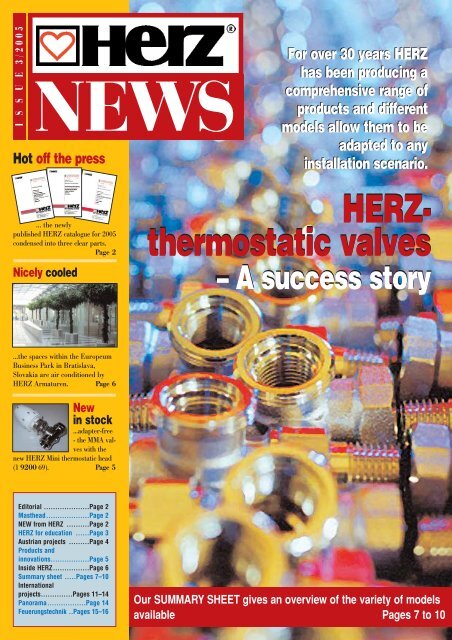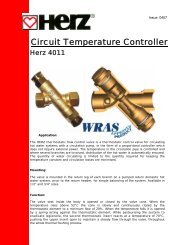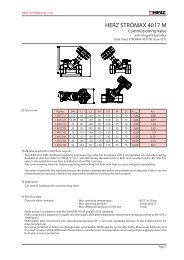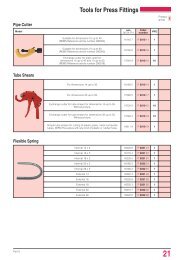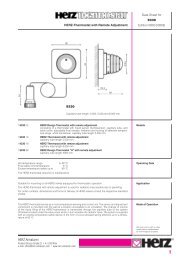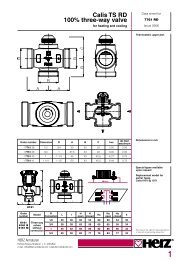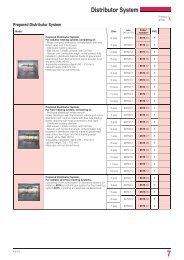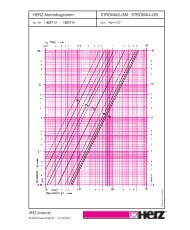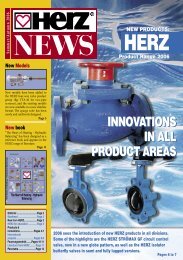Herz Valves UK
Herz Valves UK
Herz Valves UK
Create successful ePaper yourself
Turn your PDF publications into a flip-book with our unique Google optimized e-Paper software.
I S S U E 3/2005NEWSHot off the pressFor over 30 years HERZhas been producing acomprehensive range ofproducts and differentmodels allow them to beadapted to anyinstallation scenario.... the newlypublished HERZ catalogue for 2005condensed into three clear parts.Page 2Nicely cooledHERZthermostaticvalves– A success story...the spaces within the EuropeumBusiness Park in Bratislava,Slovakia are air conditioned byHERZ Armaturen. Page 6Newin stock...adapter-free- the MMA valveswith thenew HERZ Mini thermostatic head(1 9200 69). Page 5Editorial ....................Page 2Masthead...................Page 2NEW from HERZ ..........Page 2HERZ for education ......Page 3Austrian projects .........Page 4Products andinnovations.................Page 5Inside HERZ................Page 6Summary sheet .....Pages 7–10Internationalprojects..............Pages 11–14Panorama.................Page 14Feuerungstechnik ..Pages 15–16Our SUMMARY SHEET gives an overview of the variety of modelsavailable Pages 7 to 10
EditorialEDITORIALDear customers and partners,dear friends of HERZ!Have you visited a large industry fair orperhaps several in the last year? Have youreceived the information that you wanted?Have you seen a lot of new and interestingelements, refreshed your technicalknowledge, rekindled old acquaintancesand made new contacts? Yes? Then yourtrade fair visits have clearly been worthwhile!HERZ too was represented atnumerous trade fairs at home and abroadin the first half of 2005, and one of thehighlights was, of course, ISH in Frankfurt-am-Mainin mid-March. In an enlargedstand area HERZ presented itsentire product range and the latest NEWSto customers and partners from all overthe world.Following the successful presentation inFrankfurt, the next large event in the diarythis time was in Austria – the formerAquatherm, now extended and known asE.R.G., Energie.Raum.Gebäude. (theinternational trade fair for housing technologyand building services) at the exhibitionsite in Vienna. Many commentatorshave already expressed their opinion inaddition to the mixed feelings that existwith regard to this trade fair and hardlyanyone has escaped criticism. HERZ toohas made some observations. Perhaps thepassage of time and the resulting dissipationof the annoyance will temper thecriticism.According to the organisers of the tradefair, it was a wish expressed commonly bythe majority of exhibitors that the eventbe held straight after ISH. From our perspectivethe dates were poorly chosen,and the lack of visitors, particularly onthe first day of the fair, confirmed ourview. Removal of the Aquatherm brand isa shame, as this concept was well knownnot only in Austria but internationally.The reasons behind the change of name toERG has been given far too little publicity,and the new name meant almost nothingto anybody, with most customersasking what the abbreviation stands for.The connection with the former Aquathermplumbers trade fair has thereforebecome completely lost, and an importantaspect of the recognition has been quicklydiluted. In spite of all this, we hope for thesake of visitors and exhibitors alike thatthis, the largest, domestic trade fair, willkeep going in a reasonable format. HERZwill certainly be present to show its coloursat the next event in 2007 as one ofthe biggest Austrian producers. Under themotto “from now on the only way is up!”we look with confidence towards the futureof this home trade fair.YoursDr. Gerhard GlinzererManaging DirectorNEW FROM HERZHERZ-Product Range2005Greater clarity thanks to the newdivisionsIn order to improve its clarity theHERZ 2005 product range has beencompletely restructured. The “accrued”HERZ catalogue which was already inseven parts has been summarised intothree parts, and product duplicateshave been taken out. All parts are nowaccompanied by a product photo, insteadof being shown with drawings aswas the case before. To illustrate thenumerous areas of use of HERZ products,each part contains a number ofusage examples.Part 1 NEW:HERZ control engineering:Gives information on thermostats andspeed drives, thermostatic and controlvalves, room temperature controls, electroniccontrol components and radiatorconnection fittings (formerly part 1 andpart 2).Part 2 NEW:HERZ supply engineering:Gives information about pipe and circuitfittings for medium distributionand control of home technology pipenetworks (formerly parts 3, 6 and 7).The larger HERZ stand at the ISH trade fair in Frankfurt 2005.... we enjoyed a steady stream of visitors.MASTHEADHERZ NEWS, the customermagazine of HERZ Armaturen.Media owner, publisher andeditor:HERZ Armaturen Ges.m. b. H.,Richard-Strauss-Str. 22,A-1230 Vienna,Tel.: +43/(0)1/616 26 31–0,Fax-Extension –27,Editor: Mag. Gudrun Haigermoser,HERZ Armaturen, Vienna.Layout and graphics: Alexander Fauland.Production: Odysseus Printing.Circulation: 10,000 copies, issued quarterlyPart 3 NEW:HERZ connection engineering:Gives information about all pipe connectionand pipe laying components includingaccessories for surface heatingand cooling (formerly parts 3, 4 and 5).New in this part is the HERZ surfaceheating and cooling product group.The new catalogue is available in Germannow. The issues in other languages will beproduced during this year. For more informationplease contact your HERZrepresentative.2 3/2005
HERZ supports ecucationOdessa: Honorary doctorate for Austrianhousing technologyThe rector of the buildingacademy in Odessa, VitalijDorofeev, handed overthe honorary doctorate tothe managing director,Gerhard Glinzerer in April2005 and thanked HERZfor supporting the studenttraining.Profound training ensures afuture occupationHERZ promotes language courses for students fromBosnia and CroatiaClose co-operation with educationalinstitutions and promotion of trainingin the field of housing technology,in Austria as well as internationally,has been a concern of HERZ for a long time.Collaboration with Ukraine has alreadybecome a tradition here. The annualHERZ specialist lectures at the colleges ofbuilding in Kiev, Dnepropetrovsk andOdessa and the ongoing relationships withthe colleges in Lemberg and Poltava areonly a part of this co-operation in the fieldof training. As an acknowledgment of thecommitment of HERZ and their supportof student training, managing director,Gerhard Glinzerer was awarded the titleof honorary doctorate on 21st April 2005from the building academy at Odessa. Duringthe three years or more of co-operation,HERZ has equipped a laboratory, organisedlectures, student competitions andstipendiaries for the best students andsupported the academy’s basketball team.As an industrial company that isactive worldwide, HERZ appreciatesgood language training andis therefore already supporting the initiativeof the Croatian cultural association,NAPRADEK for the third time thisyear, to make it possible for gifted studentsto attend a language course – associatedwith an interesting supporting programmein Vienna. In its own programme,the Vienna-based cultural associationpromotes German language coursesfor students from Bosnia-<strong>Herz</strong>egovinaand Croatia. In its position as marketleader in these countries, HERZ is alsoconcerned with supporting the trainingof the students there. During the threeweeksummer language course, alongsidethe German language, the studentsalso learn about Austrian culture, thesocial and educational system and theeconomic background. A visit to theHERZ production department is also afixed part of the student’s stay. In thediscussions following the factory visit,there is emphasis upon the importanceof good training for a future in a qualifiedposition.During their language course organised bythe Croatian cultural association, Napredak,the students also visit the HERZ productionsite in Vienna.HERZ-job vacancies: Are you interested in bringing your professional capabilities in to a successfuland expansive company with an international background and further developing these skills? Click on ourjob vacancies/Jobbörse at www.herz-armaturen.com (German version) and find out about our vacantpositions at HERZ Armaturen. We are happy to receive applications from committed people at any time!3/2005 3
Austrian projectsCustomised systems for heatingrenovation in the public building sector”Wiener Wohnen”with HERZHERZ Switch fix enables pipeconnection without crossoverVienna city council which is responsible for public building and the renovation of existing housing,known as "Wiener Wohnen", has been searching for an ideal solution for the new building and therenovation of heating systems in existing housings. A solution, which on the one hand reduces materialsand work time and on the other hand guarantees an energy saving and trouble-free operation.Another requirement of the tender was an attractive appearance.HERZ Armaturen was able to offer asolution which covered all the necessaryrequirements and offeredvarious product packages. Numerous houseinstallations in Vienna have been or willbe renovated by HERZ-Armaturen. Buildingpromoters and power suppliersthroughout Austria took note of the advantagesof these packages and similar projectshave therefore already been plannedin other provinces.Pipe connection without crossoverand flush mountingPipe connection without crossover is one ofthe major advantages of the HERZ connectionsystems. Thanks to these systems youcan save time and material expenses can bereduced. By using distributors for flushmounting for radiator connections there isno need to use connection pieces for flooror wall mounting. Leaky parts can thereforebe avoided and the longevity ensured.PROJECTS:Mühlschüttelgasse residential installation, Vienna 21Executing plumber: Huber company, Vienna 11Approximately 300 connection systems (approximately 60apartments), finished in March 2005.Ehammgasse residential installation, Vienna 11approximately 300 connection systems (approximately 60 flats),Executing plumber: ERGE Beranek, Vienna 11,currently under construction.Executing plumber: Caliqua companyapproximately 250 connection systems (approximately 40housing units), currently under construction.Clean appearance andeasy maintenanceWhen pipes are installed in the floor or walland the radiator connection is flush mounted,the tubes are “invisible”. In the case ofnecessary maintenance works, equipmentcan be accessed from the wall. Simply openingthe lid of the covering box avoids thedifficulty of opening the wall or floor.A pressure test of the heatingsystem is possible without theradiatorBy flush mounting and the use of shut-offconnection systems the radiator connectionsmay be completed during the rawconstruction phase. Using HERZ Switchfix, the flow and return can be individuallyset which means further simplification ofthe installation planning. The radiators nolonger have to be installed during the rawconstruction phase for pressure testing,then having to be removed again. Using thenew method, the radiatorsare only mounted once allpaint work is completed .This saves valuable time andstorage costs.Installation in pictures(Project “Mühlschüttelgasse”, HERZ doubleconnection distributor)Customised product solutionsfor any renovationeventualityHERZ offers various packagesto cover the different requirementsof the dwellings to be renovated.All these packages includea thermostatic valve andthermostatic head, a connectionsystem for radiators, one pipe, press fittingand screw coupling (one piece each). Mostof the variants are flush mounted. If skirtingboards and a skirting board connection distributorare used, surface installation is necessary.The two most common variants of the customisedproduct packages are, on the onehand, the one using a HERZ reverse distributorfor dual-pipe systems – the HERZ-Switch4 3/2005
Products and innovationsfix, and on the other hand, the HERZ doubleconnection distributor for dual-pipe systems.Both sets are suitable for pipe connections withoutcrossover. Additionally, the Switch fixcan be shut-off and you can switch betweenflow and return.VARIANT 1HERZ Switch fix reverse distributor(1 3030 01)■ Double connection distributor, verticalpipe mounting in floor■ The connection system is mounted in theflush box■ Choice between flow and return, shutofffunction■ Threaded pipe connection 4 x G 3/4 withcone and 2 x G 3/4 with cone on the radiatorside, according to DIN V3838■ Including flush box and coverVARIANT 2HERZ double connection distributor(1 4133 01)■ Double connection distributor, verticalpipe mounting in floor■ Threaded pipe connection 4 x G 3/4 withcone and on radiator side 2 x G 3/4 withcone, according to DIN V3838■ Flush box and coverVARIANT 3A variant withhorizontal walloutlet is currentlybeingplanned. Usingthis variant thepipes are installeddirectly inthe wall and thefloor coveringneed not be removed.NEW: HERZ Mini thermostatichead (1 9200 69) for MMA valvesEasy to retrofit and change!HERZ Minimounted onMMA valveBetween 1980 and 2000, MMA valves(Markaryds Metal Armatur), producedby Stelrad Radiatoren GmbHhave been widely used in Austria. For theversions HB45, TAG, D12, E12, etc., HERZnow offers its own version of the Mini thermostatichead (item number 1 9200 69)The new HERZ Mini MMA thermostatic headcan be used without an adapter to replacethe MMA head and it can be installedon the existing lance valve.which can be used to replace the Makarydheads. The new HERZ Mini MMA – withoutadapter – is suitable for■ all MMA thermostatic valves, versions1988 and later■valves and valve connection systems forStelrad TPAV and TCV up to 1994 versionsThe turbulator valve with hand wheel, modelStelrad HB45, versions 1982 to 1989, which isused in Austria, can be retrofitted with the MiniMMA thermostatic head.■ valves and valve connection systems forthermopanel radiator versions from 1992and later■ valves and valve connection systems forAGA/Stelrad Compact 32/2, modelsfrom 1978 to 1990.Mini MMA technical data■ M 28 x 1.5 threaded connection■ Freely moving nut, across flat HEX 30■ MMA closing dimension■ Zero position, frost release at approx.6°C, adjustable■ Set value range 6–30 °C■ Limitation and locking of nominalvalue range3/2005 5
HERZ Company newsHERZ builds on the future ofEuropean productsNew production site acquired for cast iron productWith the acquisition of a controllingshare in the company, S.C.Armatura S.A. in Klausenburg(Cluj-Napoca) in Siebenbürgen, which isquoted on the Bucharest stock exchange,HERZ is expanding its group of companiesto include a specialist in the manufactureof grey cast iron and malleable cast ironproducts. Around 630 staff at this company,which has been in existence for over120 years, produce grey and malleable castiron products as well as brass and bronzeproducts for the Romanian market and forexport. Flanged grey cast iron products inparticular are manufactured specially forthe HERZ group. The company, which isunder Austrian regulation, is certificatedaccording to ISO 9001.Before leaving the factory, HERZ valves undergoprecise checking on the test bench.A common history as a basis forEuropean co-operationAustria has a long common history associatedwith Siebenbürgen. Its geographicalproximity to Vienna, just a few hours awayby road, is just one of the advantages of thenew site. In contrast to other manufacturersin the industry, many of which have alreadytransferred their production to China,HERZ places importance upon the qualitywithin Europe and markets products whichare manufactured within the EuropeanUnion or in what will be future memberstates.Siebenbürgen (Transylvania) – manynames and a turbulent historySiebenbürgen is known by many names –the description derived from the Latin –Transylvania (= the land beyond thewoods) was the most widely used in medievaldocuments. In literature Transylvaniabecame known through Bram Stoker’sDracula. The plot of this story is partly setin this region and is based on the traditionswhich surround Count Vlad Tepes. TheHungarian name is Erdély (roughly translatedfrom Erdö – the wood), and theRomanian name in the same vein is Ardealor Transylvania. The origin of the Germanname Siebenbürgen is not explainedconclusively. Presumably it goes back tothe first seven towns established by Germansettlers (the Siebenbürger Saxons) –namely, Kronstadt, Schäßburg, Mediasch,Hermannstadt, Mühlbach, Bistritz andKlausenburg.PositionGeographically, Siebenbürgen todayis the centre and the north-westernpart of Romania. Siebenbürgen is separatedfrom other areas of the countryby the East Carpathian andTransylvanian Alps, which togetherform the so-called Carpathian Arc.Today Siebenbürgen is around the samesize as Austria with a surface areaof approximately 80,000 km 2 .KlausenburgKnown since 1974 as Cluj-Napoca,and previously just called Cluj (Ger-The HERZ flag isflying in front of thenew production sitein the town of Klausenburgin Siebenbürgenwhich iswell known as an industrialcentre. Thecompany S.C. ArmaturaS.A., famousas a specialist inthe manufacture ofgrey cast iron products,recently becamepart of theHERZ group ofcompanies.man: Klausenburg, Hungarian: Kolosvár)is the capital city of the Cluj region inSiebenbürgen. There has been a settlementat the site of the current town sinceprehistoric times, which developed intoan important traffic junction. In the 13thcentury the town was rebuilt by Germansettlers, the Siebenbürger Saxons. TodayKlausenburg is one of the most importantcultural economic and academic centresof the country. Of the six universities inthe town, the Babes-Bolayi University,with twenty faculties, is one of the mostimportant in Eastern and CentralEurope, and as a trilingual university(German, Hungarian and Romanian) it isunique in Europe.A common history of more than 400 yearsconnects Austria and Siebenbürgen(the map shows Central Europe in 1880).6 3/2005
Products and innovations – summary sheetHERZ thermostaticvalvesTechnically perfectedsystems for thehighest qualitydemandsHERZ thermostatic valves fulfil thehighest requirements of technologyand comfort and they correspond tothe European standard, EN 215. Combinedwith HERZ thermostatic heads, theyhelp to decrease the energy consumption ofevery water heating system and therebythe heating costs. Different designs allowadaptation to any installation conditions sothat the thermostatic head is always installedin a favourable heat flow position.The variety of types guaranteesfurther development and reliabilityA broad variety of body shapes and valvecones are offered to correspond with themost diverse market requirements. On theone hand HERZ invests in the continuoustechnical development of its products andon the other hand HERZ attaches greatimportance to the consistency of majorfunctional parameters to guarantee the replacementof accessories over decades.Therefore the M 28 x 1.5 thread (thermostatichead), the valve closing dimensionund the valve lift remain unchanged foryears. Thus every HERZ thermostatic valvegoing back to 1978 can be retrofittedwith the current HERZ thermostatic heads.Naturally HERZ has its own thermostatichead model (1 7235 01) which isavailable for all thermostatic valves producedprior to 1977. HERZ valve modelsfrom 1977 to 1990 may be retrofitted withthermostatic upper parts (1 6376).Model Colour Protection Pre-setting Single- Dual-pipe Area of applicationcappipeTS 90 White X StandardTS 90 V Red Continuously X District heating,adjustable,StandardconcealedTS 98 V Orange Continuously X District heating,adjustable,Standardwith displayTS FV Cyclam Precise control X District heating,with displaycondensing boilerspre-settingTS 90 E Grey Resistance can X New single-pipe systemsbe reducedTS E White Maximum flow X Gravity systems,old single-pipe systemsCalis White* X Vertical single-pipesystems* (blue for model with 100 % distribution)Tested according to EN 215Today, independent institutes are responsiblefor the control and registration of thermostaticvalves according to the Europeanstandard, EN 215. This testing is periodicallyrepeated so that ongoing conformitywith the standards can be guaranteed.HERZ products are also continuouslytested in-house for conformity to thestandards.According to the standard dimensions forstraight or angle valve models, nowadaysseveral series* such as “F”, “D”, “S” und“GB” are produced in DN 10, 15 and 20.Additionally the series “special angle”(angle valve with flow reversing function)and three-way valves are available. Forsingle-pipe, gravity and steam systems weoffer special valves up to DN 25. In generalall types are equipped with both, a socketthread according to ISO 7/1 for steel pipeconnection and an external thread G 3/4(according to DIN V3838) and M 22 x 1.5with inner cone for copper, soft steel or plasticpipe connection. For special areas ofapplication such as the zone valve, externalthreads with flat seals are also available.Another variant is the thermostatic valvewith an integrated bleeding valve.* D(DIN): The dimensions are based on the former German valvestandard *F (FN): French standard *S: Swedish standard *GB:British standard3/2005Please continue reading on page 10.7➠
HERZ thermostatic valves – summary sheetTS 90, internal threadF 1 7723 901 7723 911 7723 921 7723 93TS 90 V, internal threadF 1 7723 651 7723 671 7723 69TS 98 V, internal threadF 1 7723 651 7723 671 7723 69TS 90 De Luxe, internal thread1 7923 411 7923 421 7923 431 7923 441 7923 45Straight modelAngle modelF10 to 251 7724 901 7724 911 7724 921 7724 9310 to 251 7728 901 7728 911 7728 97Straight modelAngle modelF10 to 201 7724 651 7724 671 7724 6910 to 201 7728 651 7728 67Straight modelAngle modelF10 to 201 7724 651 7724 671 7724 6910 to 201 7728 651 7728 67Straight modelAngle model151 7924 411 7924 421 7924 431 7924 441 7924 45S 7924 XX151 7928 411 7928 421 7928 431 7928 441 7928 45Special angle3-axes, AB10 to 201 7758 901 7758 9110, 151 7759 901 7759 91Special angle3-axes, AB10, 151 7758 67151 7759 67Special angle3-axes, AB10 to 151 7658 67151 7659 67Special angle3-axes, AB151 7958 411 7958 421 7958 431 7958 441 7958 451 7958 49151 7959 411 7959 421 7959 431 7959 441 7959 453-axes, CD10, 153-axes, CD153-axes, CD153-axes, CD15TS 90, external thread1 7733 81TS 90 V, external thread1 7733 67TS 98 V, external thread1 7633 67TS E1 7723 111 7723 021 7723 03Straight model151 7724 37Straight model151 7738 67Straight model151 7638 67Straight model15 to 251 7724 111 7724 021 7724 03Angle model151 7748 91Angle model151 7748 67Angle model151 7648 67Angle model15 to 251 7728 111 7728 021 7728 03Special angle151 7745 91Special angle151 7745 67Special angle151 7645 67Special angle15 to 251 7728 213-axes, AB151 7746 913-axes, AB151 7746 673-axes, AB151 7646 67Special angle, air valveTS steam151 7724 631 7724 643-axes, CD153-axes, CD153-axes, CD15Angle model20, 25Legend article number shape dimension model/version8 3/2005
Model DTS 90 kvTS 90 EControl valvesTS 901 7723 951 7723 961 7723 971 7713 691 7713 791 7713 891 7713 991 7723 01TS E FD1 7723 411 7723 741 7723 42Straight model10 to 20Straight model10, 15, 20Straight model15Straight model15, 20TS 901 7724 951 7724 961 7724 971 7714 691 7714 791 7714 891 7714 991 7724 01TS 90/TS EF, D1 7724 38(see picture)1 7724 201 7724 21Angle model10 to 20Angle model10, 15, 20Angle model15Angle model15, 20TS 90 V1 7723 661 7723 681 7715 691 7715 791 7715 891 7715 991 7728 01TS 90 ÜM1 7723 22Straight model10, 15Straight with elbow10, 15, 20Special angle15Straight model10TS 90 V1 7724 661 7724 681 7718 691 7718 791 7718 891 7718 991 7758 01TS 98 VÜM1 7637 25Angle model10, 15Special angle10, 15, 203-axes, AB15Straight model15TS 98 V1 7623 661 7623 681 7716 691 7716 791 7716 891 7716 991 7759 01TS E ÜM1 8477 431 8577 43Straight model10, 153-axes, from10, 15, 203-axes, CD15Straight model20, 25TS 98 V1 7624 661 7624 681 7717 691 7717 791 7717 891 7717 99Zone valvesControl valvesAngle model10, 153-axes, CD10, 15, 20StrömaxTS 901 7217 11Floor Fix1 8100 101 8100 11TS FVTS Export models1515D1 7523 68GB1 7734 331 7734 311 7734 38StrömaxTS 98 V1 7217 67Zonevalve1 7723 82Straight model151515Straight model20D1 7524 68TS 901 7833 201 7834 20StrömaxTS 90 E1 7217 211 7217 31TS 90 HD1 77XX 26Angle model15Straight + Angle1015Straight model15F1 7523 67TS 901 7742 91StrömaxTS E1 7217 X11 7217 X21 7217 X3TS 98 V HD1 76XX 26Straight model15Special angle1515 to 25Straight model15F1 7524 67TS 98 V1 7637 681 7645 681 7646 68Controlvalve1 7760 011 7760 021 7760 031 7760 041 7760 051 7760 061 7760 08Angle model15DG, AB, CD with bleed function10 to 20Straight model10 to 203/2005 9
HERZ thermostatic valves – summary sheetDifferential pressure measurementwith HERZ Changefix andmeasuring computer.For dual-pipe heating systems we producethermostatic valves with or without presetting.The pre-setting option can bechosen according to the various requirementsof machine operators, energy supplycompanies etc.:■ adjustment not possible for unauthorisedthird parties■ adjustment only possible with specialtools■ adjustment freely permitted.These valves are produced in dimensionsDN 10, DN 15 and DN 20 and are suitablefor all types. Also flow ranges from “smallestdrops to waterfall” are possible.Technical DataThe maximum permissible differentialpressure for all HERZ-Thermostatic valvesis 0.6 bar, with the exception of dimensions3/4 and 1 with 0.4 bar and HERZ-TS-90-E and HERZ-TS-E with 0.2bar. The maximum operating temperatureis usually 120°C while themaximum operating pressure is 10bar. Special designs (7760) are alsoavailable for PN 16 or an operatingtemperature of 130°C. For non-installedvalves the storage temperatureis between -40°C and 60°C. Toavoid contamination and debris onthe valve, the hot water quality mustfulfil the conditions according toÖNORM H 5195 and/or VDI-Regulation2035.In order to reduce noise during operationthe differential pressureshould be determined in accordancewith the “VDMA instruction sheetFlow rate [l/h]for planning and hydraulic balancing ofheating systems with thermostatic radiatorvalves” (max. 0.2 bar).ModelsHERZ radiator valves sizes 3/8 – 3/4 areuniversal models with special sockets, exceptHERZ-TS-E. They are suitable forconnecting threaded pipes with a pipe threadand copper, soft steel or plastic pipes,the latter three by means of a compressionunion. HERZ 1" TS valves and HERZ-TS-E valves are standard models with a pipecoupling for threaded pipes.Changing the valve and differentialpressure measurement by meansof HERZ ChangefixYou can use the HERZ Changefix tool(7780) to replace the valve upper partwhile the system is under pressure. TheSince the early 1970s HERZ has produceda wide range of thermostatic valves madeof high-quality brass (brass alloys) usingchill casting or drop forging methods.The picture shows an extract from theHERZ product range in 1977tool is mounted on the valve and as well aschanging the valve insert you can also cleanthe seat; using a separate centre piece.HERZ Changefix can be used for allHERZ TS- 90, TS-90-E, TS-90-V, TS-90-kV (all types DN 3/8 until 3/4) thermostaticvalves, and for HERZ-TS-kV and HERZ-TS-DIN (old model, all types). By usingHERZ Changefix + the pressure measuringaccessories (7781) + a measuringcomputer you can measure the differentialor static pressure across the closed valve.Range of application for pre-adjustable thermostatic valve at 2[K] p-variance and dp = 5[kPa]Pre-setting levels10 3/2005
International projectsHERZ thermostats and the Pipefix system were used for the renovationof the attractive 17th century cathedral of Bogojavlensky in Tomsk.The new construction of a branch of the Russian Central Bank in Novosibirskincluded HERZ four-way valves, Mini thermostatic heads, STRÖ-MAX R and MFS as well as HERZ differential pressure and volume flowcontrols.HERZ in SiberiaIn Siberia, a country in which the winter temperature in some towns in the northeastfalls as low as -70°C, heating is of course a core theme of daily life. The set-up in mid-2004 of the subsidiary company, HERZ Sibir, has meant improved and fastercustomer care in the region.HERZ products have been availablein Siberia for a long time throughour subsidiary company in Moscow.In order to be better able to develop thisvast region and to offer customers there afaster service, the subsidiary company,HERZ Armaturen Sibir, based in Novosibirskwas set up in August 2004. Novosibirskhas a population of around 2 millionand is the centre and the capital of the administrativeregion of Siberia, which occupies30 % of the total area of Russia.Around Novosibirsk there are other largetowns of the region such as Omsk, Tomsk,Barnaul, Krasnoyarsk, Kemerovo andNovokusnezk, which are run from there.Full coverage customer care is not straightforwarddue to the size of the region and theInteresting and special factsMap: Russian FederationThe huge expanse of Siberia, with a total area of over 10 millionkm 2 (compared to Austria’s area of around 84,000 km 2 ) stretchesout between the Urals and the Pacific, the North Pole Sea,Mongolia and China. One of the richest regions of Russia, andone which was once closely associated with the concepts of exileand forced labour, it is now one of the most significant industrial,economic and cultural regions in eastern Russia, as well as being atravel destination for lovers of nature and extreme tourists. Theclimate of Siberia is continental, with the average annual temperatureacross the whole of Siberia being 0°C. In some town in northeastSiberia the temperature in winter falls to –70°C. Six million km 2 of Siberia is covered in permafrost, and the depth of permafrostreaches up to 1,500 metres. The vegetation zones of Siberia are divided into Arctic cold desert, tundra, forest tundra, boreal forest,forest steppe and steppe. The boreal forest middle and eastern Siberia forms the largest continuous forest area on the earth. Siberia isrich in natural resources which have been systematically developed since the 20th century. Amongst the most important to be foundare petroleum, natural gas, coal, iron ore, non-ferrous metal ores, bauxite, gold, platinum, diamonds, copper, lead, zinc, tungsten, tin,salt, and others.3/2005 11
International projectsimmense distances – and further HERZlocations are therefore currently beingplanned in Irkutsk (eastern Siberia) andChabarovsk (in the far east of Russia and5,000km from Novosibirsk).The whole HERZ product range is beingused. Two of the largest projects are thebranch of the Russian Central Bank and the“Narymskaja Zhemtschuzhina” residentialcomplex in Novosibirsk, which was builtfrom new with the help of HERZ Armaturen.The famous Trans-Siberian railway runs along10,000 km of railway track right across the country.The famous Trans-Siberian Railwayis one of the most importanttransport systemsIn the middle of the 19th century the seedof the idea to build a stretch of railwayright through Siberia was already germinating.With 100,000 workers and after 25years under construction, the 10,000kmlongrailway line from Moscow through theUrals, past Lake Baikal to the Pacific portof Vladivostok had taken shape.Construction began in 1891, and the biggestproblem was the Lake Baikal region.Then a ferry operation was set up to crossLake Baikal and if it was frozen then therailcars were pulled across the lake onsledges. During the Russo-Japanese Wartracks were even laid on the ice of LakeBaikal. However, in 1905 a stretch of railwas completed around the southern end ofthe lake so that the eye of Lake Baikaldisappeared.The Trans-Siberian now ran from Moscowvia Novgorod – Perm – Ekaterinburg –Omsk – Novosibirsk – Tayshet – Irkutsk –Lake Baikal – Ulan Ude – Chita andChabarovsk to Vladivostok. In 1961 it waselectrified up to Irkutsk. Today the wholestretch is catenary wired.In Ulan Ude the Trans-Siberian branchesoff through Mongolia via Ulan Bator toBeijing. At the Mongolian-Chinese border,however, the trains have to be convertedfrom the Russian broad gauge to the Europeanstandard gauge which exists in China.In the area of Lake Baikal, the stretch waslater laid from the banks inland, and theone-track, non-electrified stretch was leftdormant. Today special trains are onceagain travelling the many kilometres of oldTrans-Siberian running along the banks.Later on another stretch – the Amurstretch – was built on Russian soil, a littlefurther away from the Chinese borderthat runs parallel with it. This runs fromTayshet to Chabarovks north past LakeBaikal. The Trans-Siberian has offeredtourist journeys for many years. In thebeginning it was only possible to travelwith timetabled trains, but in recent yearsmany special trains have been added,which run along the line towardsVladivostok as well as on the Trans-Mongolianto Beijing.Ukraine: Art with HERZWith his sculpture, a completely new field of application for HERZ products is beingdeveloped by the Ukrainian artist, Mikhail Kolomej.His “World Businessman” made of nickel-plated copper pipe and bypass fittings andother HERZ components, flies the HERZ flag high and shows the way towards newmarkets.Bus with HERZSince May 2005, the environmentally friendlytrolley bus in the southern Ukrainian town ofZaporozhje has been a suitable means ofadvertising for energy-saving products fromHERZ Armaturen.12 3/2005
International projectsSlovakia: Europeum businesscentre in BratislavaHeating and cooling with HERZ ArmaturenThe EUROPEUM business centrecompleted in 2004 in Bratislava,Slovakia is a major project onwhich HERZ products have been deployedon a large scale in the fields of heatingAND cooling. The subsidiary company,HERZ Slovakia s.r., supplied fittingsand control elements for room temperaturecontrol and hydraulic balancingof heating and cooling equipmentduring 2003/2004.The building and its hot and coldsupplyThe rooms to be supplied are mainly offices aswell as business premises and a café and adjoiningrooms.The heating equipment is operated by agas boiler which is situated on the firstfloor. The equipment consists of warm waterheating of 554 kW and air heating of615 kW.The control of the heating equipment is carriedout via ten control circuits. Seven supplythe offices, the businesses, the café and the adjoiningrooms, two control circuits operatethe air heating for the boiler house, the machineroom andthe gate air curtain.The horizontalmain supplypipes are fed underthe ceiling ofthe first basement.In the risers up tothe single ascendingheating pipesHERZ STRÖMAX4217 GM circuitcontrol valves areinstalled in conjunctionwithHERZ 4007 differentialpressurecontrols. The machineroom of theventilation equipmentand everygate air curtain isalso equippedwith HERZSTRÖMAX 4117 M circuit control valves.The pipes are made of welded, seamless threadsteel pipes.The cooling equipment with cold water setis situated in the machine in the secondbasement and consists of a fan convector(650 kW) and ventilation equipment(314 kW). The main supply pipes for thecooling are mounted horizontally on thebasement ceiling.The office areas are heated andcooled with fan coils. These areconnected in a four-conductormethod.3/2005 13
Panorama – AustriaTechnical data:Heat output■ 1,170 kW at 80°C/60°C flow / returntemperatures■ -12°C external temperature, min.22°C room temperature;■ Medium - waterCooling requirement■ 965 kW at 6°C/12°C flow / returntemperatures■ 32°C external temperature. 26°Croom temperature;■ Medium - waterFrom this so called loop the central riserslead vertically into the upper floors. Thepipes for the floors branch off again to supplythe individual fan coils. These horizontalcooling water distributor pipes are laidtogether in the false floor with the centralheating pipes.The fan coils in the office areas are equippedwith the following HERZ products inthe field of heating:■ DR-T-90 control valves■ STRÖMAX TS-90-E thermostatic valveswith measuring nipples■ 7710 thermostatic valves.In the field of cooling■ HERZ-GP control valves■ HERZ thermostatic valves with STRÖ-MAX TS-90-E test points■ HERZ 7710 electro-thermal driveswere used.The heating medium temperature iscontrolled in the boiler house independentlyof the external temperature. Thecapacity of the fan coil is controlledusing a room thermostat. The supplycircuits with the shut-off and controlfittings branch off the risers. The pipesoff the risers lead to the individual fancoils in the false floor. The café and businessareas are equipped with warmwater floor convectors with HERZ-DR-T-90 regulation valves and RL-5 returnvalves as well as with steel panel radiatorswith built-in valve fittings (RL-5and MINI thermostatic head) and/or viawarm air through air heating. The pipedistribution from the risers to individualfan coils lead through to the floor ofthe ground floor and every pipe branchingoff is equipped with HERZSTRÖMAX 4117 M shut-off and controlfittings.SERIES: The Austrian industry museumsToilet and plumbing items –the museum for historicalplumbing artefactsin GmundenIn this unusual museum there are more than 300items from the field of bathroom ceramics, representingthe history of hygiene.In 1998 the unique collection of raritiesfrom the town of Gmunden put togetherby Fritz Lischka from the Laufen companyover the years, has been made availableon permanent loan and has found anew home in the protected “Pepöckhaus”in the Traungasse.Since then the costly artistically designedwashbasins, toilet lids, bidets – includingone that belonged to Empress Elisabeth –bathing chairs and baths – are now on showto the public. The exhibition gives an interestingoverview of changing hygiene throughthe ages and the varied history of the WC.The history of the bath and WCA toilet with a kind of water flush existed inancient times, and forerunners of our flushingtoilets today were first invented in the16 th century. The inventor of the first modernwater closet (WC) was the Englishman,Sir John Harrington. In 1589 he hada mansion built with a WC. Indeed, thisWC still very much looked like a dunny,but it had a water reservoir from which thetoilet bowl could be filled with water. Thisfirst WC was also around before QueenHERZ customers and partners had a greatdeal of fun at the anniversary football tournamentof the Austria Gala Team versus theElektra <strong>Herz</strong> Team, which finally ended in ascore of 5-1 for the “Oldstars”. After theirperformance on the pitch, Walter “Schoko”Schachner and Heribert Weber also took careof the atmosphere at the HERZ table. WernerMocharitsch, Hans Mocharitsch junior, HansMocharitsch senior, Heimo Hojas and RolandBumberger (both ÖAG), Joachim Mastnakand Günter Brauneis (SHT), Michael Kolarand Gert Gerold celebrated together at thesubsequent VIP gala with the Styrian HERZrepresentative, Erwin Kollmann.Elizabeth I. As itwas popular, asimilar one wasinstalled at RichmondCastle.The flush wouldnot work at firstThis costly water closet(around 1800) was“disguised” as a pile ofbooks and was found inGmunden.however and temporarily gave way tochamber pots and commodes of all kindswhich often stood camouflaged as sofas oreven books in the middle of the living areas.As well as the history of hygiene and theWC, the development of porcelain in generaland ceramic bathroom products inparticular is the subject of the Gmundenmuseum. “History around the house”rounds off this walk through an unusualmuseum.Sanitärmuseum Klo & So (Plumbing museumof toilets and bathroom fittings)Traungasse 4, A-4810 Gmunden, Austria1 +43/(0)7612/794-425E-mail: museum@gmunden.ooe.gv.atwww.museen.gmunden.atOpen between 1st May and 26 th October,Tuesday to Sunday.Photo left to right, above / below: Erwin Kollmann(HERZ), DI Hans Mocharitsch,“Schoko” Schachner, Heribert Weber, JoachimMastnak and Günter BrauneisSource / photos: Catalogue of toilets and bathroomequipment / plumbing museum in Gmunden14 3/2005
HERZ FeuerungstechnikBio heat from HERZ for theBurgenland wine-growing areaThe woodchip-operated BioMatic combi equipment inNeckenmarkt with a heat output of 800 kW, takes careof environmentally-friendly energy supply.Both types of HERZ BioMatic equipmentwith a heat output of 400 kW each areequipped with their own ash extractorspecially built for the equipment.Since 22nd December 2004 the woodchip-fuelledcombi equipment fromHERZ has been operating in theBurgenland wine region of Neckenmarkt.Seven households, 28 factories and two publicbuildings are currently being suppliedwith bio heat from the local heat supplyequipment. There is also an option for heatsupply for 60 additional houses, and duringthe course of 2005 another ten wereincluded.Intelligent, automated combiequipmentThe HERZ heating equipment, which wasdesigned and built in close collaborationwith the Riebenbauer technical officeand operated by Neckenmarkt districtheating company, consists of two woodchipboilers with a heat output of 400 kWeach. Both installations of the BioMatictype are made into combi equipmentusing BioControl 3000. The intelligentcontrols on the one hand allow optimumcombustion and automation of the equipment,and on the other hand ensureequal usage and optimum deployment ofboth pieces of equipment and thus optimumprovision of fuel.The combi or twin equipment was chosenin order to achieve better coverage of thepartial load area. That means, for example,that only one unit is in operation duringthe transition period, as only part of theheat output and not the full 800 kW is required.Therefore it is always possible toachieve optimum efficiency and therebysave energy.Perfectly planned heating houseThe newly built heating house consists ofa boiler room, a control room and a woodchipstore (store capacity 1,000 m 3 ). Eachof the two HERZ boilers is loaded via tworoom extractors. The boiler equipmentwas constructed for an operating temperatureof 95°C and a maximum operatingpressure of 3 bar. The heat outlet hasbeen equipped with changeover stations,which are fitted with plate heat exchangers.Thus there is a system separationbetween the pre-insulated pipe network(primary network) and the heating equipment(secondary network) in the individualobjects.In the control room there are electronicswitchboards for electrical distributionand switchboards that contain the controland operation equipment by which thewhole plant is automatically controlled.The fuel output is carried out via removalfrom the room and screw conveyor to eachwoodchip boiler with the relevant burnbackprotection in place. In the boilerroom there is also expansion equipmentwith controls, the pump group and a12,000 litre buffer store.Automatic ash removalA special feature of this equipment is theautomatic ash removal. The ashes whichfall down from the combustion chamber,the fly ash from the automatic heat exchangercleaning system and from bothHORIZONTAL SECTION OF HEATING ROOMdrinkingwater pipecontrol roomheating roombuffermulti-cyclones are taken out in an ashremoval system designed and built byHERZ, into a container outside the boilerroom. Here it is possible to speak of almost100 % automated equipment with continuousdust submission under 25 mg/Nm 3 .This design guarantees that the boilerroom remains dust-free and clean.Through the automatic ash removal of allash waste into a container located outsidethe boiler room, with a volume of around2m 3 , the continual cleaning of the flue gasaffected parts is guaranteed. The ashwaste is also used as fertiliser.Environmentally-friendly fuel fromthe surroundingsThe fuel is stored in the woodchip store.Only untreated wood in the form of forestwood chips is used as fuel. A moveable threepartlid is attached to the roof constructionof the woodchip store. The fuel is suppliedby members of the community or externalsuppliers. Each year around 1,700 metres ofloose woodchips is required. All the woodchipis taken from Neckenmarkt’s ownforests.The ground plan ofthe boiler roomshows the configurationof the combiequipment includingdust cutterand automatic ashremoval in ahydraulically drivencontainer outsidethe heatingcentres.3/2005 15
HERZ FeuerungstechnikRed wine from Central Burgenland –a (cultural) history with a long traditionThere is more to wine than can be summarisedin a short text. Wine is a semiluxuryitem, in some respects also a foodand – as some believe – even a medicine.Above all, wine is culture – and also a veryold one.Traceable back to the Celts, the“wine boom” in Roman timesIn the central Burgenland wine-growingarea of Neckenmarkt this culture can be tracedback to the Celts. There was a big increasein wine growing in the former provinceof Pannonia, due to its favourable locationon the road to Rome. At the time of mass migration,wine-growing was very much neglected,but was rediscovered in the High MiddleAges, which resulted in a huge upturn. In the14th century, around 70,000 litres of winewas harvested from around 250 hectares ofvineyard, of which 50 % was exported – primarilyto the countries of Bohemia, Moraviaand Silesia.At the time of the Turkish wars (16th / 17 thcenturies) the vineyards were lying dormantagain. It was only after this time that winecultivation recovered as a result of intensiveprocessing and cultivation efforts. Consequently,in history the first to be mentionedwere individual types such as Allenth, Salurand Olant, in which red wine was dominant.Of the greatest importance for the Neckenmarktwine industry is an entry in the InventariumVinorum of 1639, which statesthat in Neckenmarkt in 1637 “eight-and-ahalfbuckets (433 litres) of Ausbruch wine”was harvested. The famous lokajer-Ausbruchonly appears in the records in 1655.For many years the highest average yield ofall the vintages was at that time 2,000 litresper hectare. That is around a fifth of today’sper hectare yield.Blaufränkisch was the 19th centuryleader of the red winesAt the end of the 18 th century, the cultivationof new varieties of grapes began in thevintner schools of Eisenstadt and Ödenburg.First the vine louse disaster at the endof the 19 th century and the processing ofvine-louse immune-based vines led to theultimate breakthrough of wine varietiessuch as Grüner Veltliner, Traminer andRiesling. However, varieties of red winegrown as Blauer Frankentaler (Blaufränkisch)and Schwarzedler Burgunder becamemore widespread in the middle of the 19 thcentury in Neckenmarkt. Since then theBlaufränkische has developed into one ofthe leading types of red wine in Austria.The quality of Neckenmarkt wines, particularlythe home brand Blaufränkisch –Neckenmarkter Fahnenschwinger is confirmedagain and again by its successes atthe various wine fairs at a national andinternational level.Now covering more than 60 percent of thevineyards, Blaufränkisch is by far the mostimportant variety in Neckenmarkt and atthe same time is also the leading variety inall the wine-growing areas. Almost a thirdof the sites are planted with Zweigelt. Othertypes of red wine such as CabernetSauvignon or Pinot Noir only account foraround two or three percent. Equally ashigh is the proportion of white grapes.Climatically favourable andsun-kissedNeckenmarkt lies on the southern slopes ofthe Ödenburger Bergland in a tectonicallylowered aqueous trough . The natural conditionsare optimum for wine growing: Themonths from November to January arehigh in rainfall so that the soils go into thespring well irrigated. The long warm summersripen the grapes to perfection. Threechains of hills protect the area from poorweather which is brought in over the continentfrom the Atlantic. To the east, theland is flat and even and allows warm airfronts from the Pannonian lowlands toflow in.Photos: The municipality of Neckenmarkt16 3/2005


